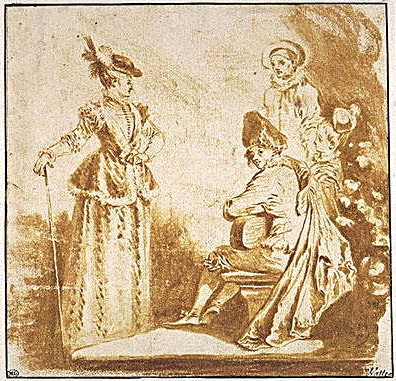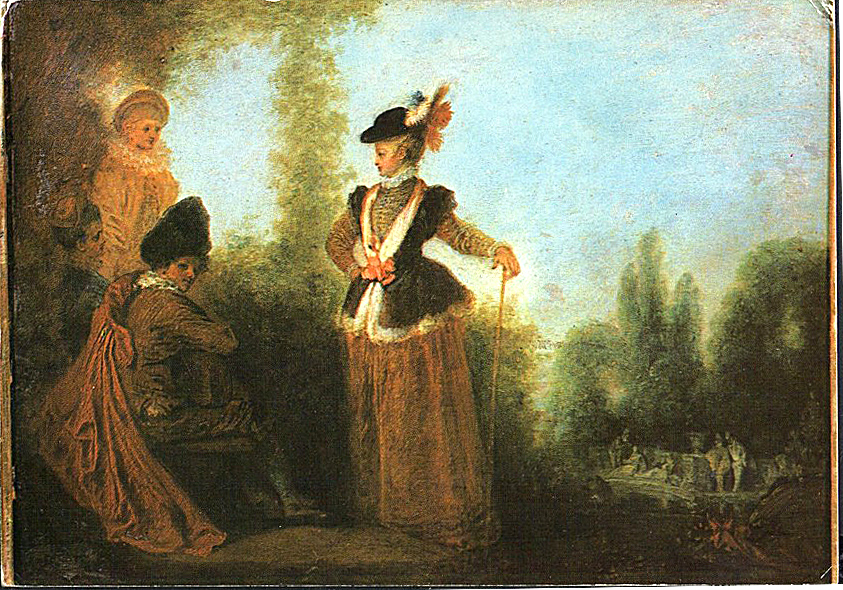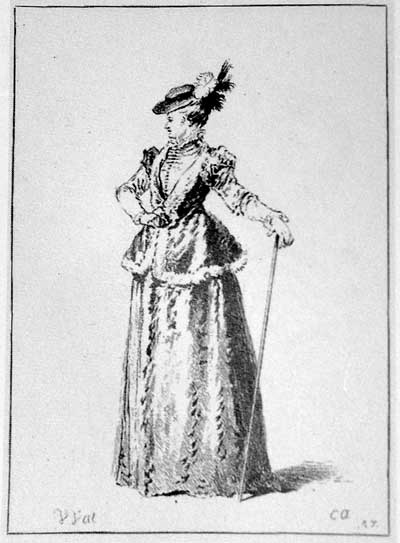
- Home Page
- Accepted
Paintings & Copies - Doubtful
Attributions - Doubtful Textual References
- Alternative
Titles - Collectors &
Museums - Bibliography
- Search Abecedario
- Watteau &
His Circle
L’Avanturière
Entered November 2015; revised January 2020
Troyes, Musée de beaux-arts, inv. 835.16
Oil on copper
18.8 x 25.5 cm
ALTERNATIVE TITLES
L’Aventurière
Die Abenteurin
Scène champêtre
Sujet espagnol
RELATED PRINTS

Benoît Audran le jeune after Watteau, L’Avanturière, engraving, c. 1727.
Watteau’s painting was engraved in reverse by Benoît Audran le jeune for Jullienne’s Oeuvre gravé. It was announced for sale in the December 1727 issue of the Mercure de France (p. 2676).
Also, Louis Crepy fils executed an engraving after the Audran print that was cited by Pierre Jean Mariette in his "Notes manuscrites" (10: fol. 192, l.8). There are as well several other engravings after the Audran print.
PROVENANCE
Paris, collection of Jean de Jullienne (1686-1766; director of a tapestry factory). Jullienne’s ownership is not recognized on the c. 1727 engraving by Audran, but it does appear on Audran’s engraving after the pendant, L’Enchanteur: “du Cabinet de Mr de Jullienne.” At some point in the next two decades he sold the painting to Orry as explained below. L’Avanturière is not listed in the inventory of Jullienne’s collection prepared c. 1756, now in the Morgan Library & Museum, New York.
La Chapelle-Godefroy, collection of Philibert Orry (d. 1747; contrôleur général des finances, seigneur de Nogent-sur-Seine). By descent to Jean Henri Louis Orry de Fulvy (d. 1757). By descent to Bouret de Valroche (d. 1761). By descent to Jean de Boullongne (d. 1767). By descent to Jean Nicolas de Boullongne (d. 1787). By descent to Paul Esprit Charles de Boullongne.
The collection at la Chapelle-Godefroy was seized during the Revolution. The pendants L’Avanturière and L’Enchanteur were cited in a report given at a meeting of the département de l’Aube, where the paintings of a large armoire on the first floor were inventoried: “11o. deux tableaux, sujets espagnols de Watteau.”
Transferred to the Musée des beaux-arts in 1835.
EXHIBITIONS
Geneva, Musée Rath, Trois siècles d’art français (1949), cat. 129 (by Watteau, L’Aventurière, lent by the Musée des beaux-arts).
London, Royal Academy, Landscape in French Art (1949), cat. 89 (by Watteau, The Adventuress, lent by the Musée des beaux-arts, Troyes).
Paris, Galerie Charpentier, Plaisirs de France (1951), cat. 195 (by Watteau, L’Aventurière, lent by the Musée de Troyes).
Hamburg, Kunsthalle, Meisterwerke der französischen Malerei (1952), cat. 72 (by Watteau, Die Abenteuerin, lent by the Musée des beaux-arts, Troyes).
Brussels, Palais des beaux-arts, La Femme (1953), cat. 134 (by Watteau, L’Aventurière, lent by the Musée de Troyes).
Bordeaux, Musée, Paris et les ateliers provinciaux (1958), cat. 40 (by Watteau, L’Aventurière, lent by the Musée des beaux-arts, Troyes).
Montreal, Héritage de France (1961), cat. 86 (as by Watteau, L’Aventurière, lent by Musée des beaux-arts, Troyes).
Tokyo, . . . L’Art français du 18e siècle (in Japanese) (1969), cat. 42 (by Watteau, L’Aventurière, lent by the Musée des beaux-arts, Troyes).
Brussels, Palais des beaux-arts, De Watteau à David (1975), cat. 2 (by Watteau, L’Aventurière, lent by the Musée des beaux-arts, Troyes).
Moscow, De Watteau à David (in Russian) (1978), cat. 19 (by Watteau, The Adventure Seeker, lent by the Musée des beaux-arts, Troyes).
Washington, Paris, Berlin, Watteau 1684-1721 (1984), cat. P18 (by Watteau, The Adventuress [L’Avanturière], lent by the Musée des beaux-arts, Troyes).
Aix, La Passion selon Don Juan (1991), under cat. 121-22.
Taipei, National Palace Museum, De Poussin à Cezanne (2001), cat. P 84 (by Watteau, L'Avanturière Musée des beaux-arts et archéologie, Troyes).
Valenciennes, Musée, Watteau et la fête galante (2004), cat. 1, under cat. 2 (by Watteau, L’Aventurière, lent by the Musée des beaux-arts, Troyes).
Brussels, Palais des beaux-arts, Watteau, Leçon de musique (2013), cat. 39 (by Watteau, L’Aventurière, lent by the Musée des beaux-arts, Troyes).
SELECT BIBLIOGRAPHY
Troyes, Musée, Catalogue (1850), cat. 130.
Hedouin, “Watteau” (1845), cat. 21.
Hedouin, “Mosaïque” (1856), cat. 21.
Troyes, Musée, Notice sur les collections (1864), cat. 111.
Goncourt, Catalogue raisonné (1875), under cat.109. Also 397, 398
Troyes, Musée, Catalogue (1879), cat. 143.
Troyes, Musée, Catalogue (1886), cat. 180.
Staley, Watteau (1902)
Josz, Watteau (1903), 395 . no. 25.
Fourcaud, “Scènes et figures galantes” (1904), 348.
Zimmermann, Watteau (1912), pl. 25.
Dacier, Vuaflart, and Hérold, Jean de Jullienne et les graveurs (1921-29),1: 199, 3: cat. 109.
Réau, “Watteau” (1928), cat. 103.
Troyes, Musée, Catalogue (1929), cat.
Brinckmann, Watteau (1943), pl. 19.
Adhémar, Watteau (1950), cat. 124.
Parker and Mathey, Watteau, son oeuvre dessiné (1957), cat. 856.
Mathey, Watteau, peintures réapparues (1959), 68.
Gauthier, Watteau (1959), pl. 16.
Mirimonde, “Sujets musicaux chez Watteau” (1961), 261, 270.
Vergnet-Ruiz and Laclotte, Petits et grands musées (1962), 70, 256.
Eidelberg, Watteau’s Drawings (1965), 180-81.
Mirimonde, “Musiciens isolés et portraits” (1966), 144-45.
Macchia and Montagni, L’opera completa di Watteau (1968), cat. 89.
Ferré, Watteau (1972), 1: 98-99; 3: 964-65, cat. A13.
Roland Michel, Watteau (1981), cat. 128.
Roland Michel, Watteau (1984), 185, 210, 265, 273.
Posner, Watteau (1984), 153-54, 243.
Sainte-Marie, Peintures (1986), 29-30.
Rosenberg and Prat, Watteau, Catalogue raisonné des dessins (1996), cat. 416, R286, G15-16.
Temperini, Watteau (2002), 41, cat. 24.
Glorieux, Watteau (2011), 152.
RELATED DRAWINGS
In 1984, Rosenberg sought to link a study of a man’s hand holding a cane to the hand of the adventuress in our painting. Subsequently Rosenberg and Prat (cat. 416) rightly rejected this association; not only is there a difference of gender but also the fingers are positioned differently.

Watteau, L’Aventurière, oil counterproof, 17.1 x 17.5 cm. Paris, Musée du Louvre, Département des arts graphiques.
One of the most fascinating documents in tracing the evolution of L’Aventurière is an oil counterproof on paper in the Louvre. When these works were discussed in the past, they often were presented in misleading ways. For example, Adhémar called the counterproof “un dessin d’après la gravure.” The authors of the 1951 Royal Academy exhibition catalogue called this sheet “a sepia wash drawing of the whole composition, but in reverse,” as though this were a preparatory sketch for the painting. Then Parker and Mathey righted things. They demonstrated that Watteau himself made such oil counterproofs, pulling them from the canvas after he had laid out the principal lines of the design on the canvas in chalk and then reinforced the lines in a brownish oil paint. This was all before the local colors were laid on. Thus the counterproofs are a record of a transitional stage between the initial drawings and the final painting. Despite doubts that linger with some scholars, most have accepted the importance of these precious documents.
This particular counterproof reveals that Watteau established the left half of L’Avanturière quite fully on the copper plate. It can be presumed that he had previously drawn at least the major lines of the composition on the primed ground, presumably in chalk or graphite. Then, in rapid fashion, he painted in the costumes and the faces, all in surprising detail. The foreground foliage and distant landscape were filled in only at a later stage. Whereas most of the extant oil counterproofs show the texture of the canvas, here, because the painting was executed on smooth copper, no such traces are visible.
Critics are divided as to whether oil counterproofs should be considered drawings or paintings. Parker and Mathey included them among the drawings, whereas Rosenberg and Prat did not. Jean de Jullienne commissioned two engravings after the Louvre oil counterproof for the Figures de différent caractères; in other words, he considered the counterproof to be a drawing. The guitarist and the adventuress were both engraved by one artist, Laurent Cars, generally an indication that they came from a common source. Then, when they were printed, they were placed side by side as facing images, echoing the counterproof. This idea of creating such an ensemble is unique in the Figures de différent caractères. In these different ways the two prints are quite exceptional, and reinforce our premise that they were based on the oil counterproof in the Louvre.
REMARKS
There has been almost unanimous agreement that the painting and its pendant in the Troyes museum are the autograph versions by Watteau. However, de Goncourt thought that the version he knew from the Vivant Denon 1826 sale catalogue (our copy 1) was the original and that the painting in Troyes was just “une esquisse” by Watteau. After World War II and revived interest in the Denon copy, divergent opinions were expressed. When the Troyes painting was shown in 1949, it was given to Watteau but, curiously, it was described as a variant of the Denon painting, implying that the Denon picture had priority. Nonetheless, most Watteau scholars have accepted the Troyes paintings as having primacy.
There has been general agreement that L’Avanturière and its pendant are early works, but, as always, there has been little consensus as to what “early” signifies. Zimmerman suggested a wide range of dates: between 1710 and 1716. Adhémar dated the pictures to 1712-15. Posner preferred 1712-13, Mathey listed them as c. 1713, Roland-Michel cited c. 1713-14, while Rosenberg and Glorieux chose c. 1712-14.
For copies of L'Avanturière CLICK HERE




